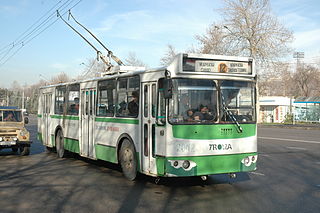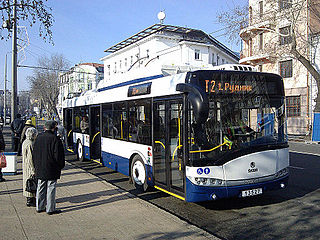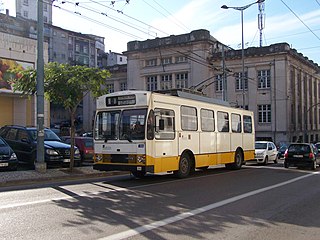
The transportation system in Mongolia consists of a network of railways, roads, waterways, and airports.

A trolleybus is an electric bus that draws power from dual overhead wires using spring-loaded trolley poles. Two wires, and two trolley poles, are required to complete the electrical circuit. This differs from a tram or streetcar, which normally uses the track as the return path, needing only one wire and one pole. They are also distinct from other kinds of electric buses, which usually rely on batteries. Power is most commonly supplied as 600-volt direct current, but there are exceptions.

The ZiU-5 is a Soviet trolleybus model that was built by the Uritsky factory. The ZiU acronym stands for Zavod imeni Uritskogo, which translates as Plant named after Uritskiy. This model of city trolleybus was in mass production from 1959 to 1972. The total number of ZiU-5s produced exceeded 14,500 vehicles. This allowed the ZiU-5 to become dominant model of trolleybus in Soviet towns and cities of that time. The last vehicles were withdrawn from active service in the mid-1980s. The small number of surviving vehicles are kept now for museum purposes.

The first trolleybus vehicle in Russia was built in Saint Petersburg in 1902 at Frese machine-building factory. It utilised a carriage-type current collector like the early von Siemens prototypes. There was no attempt to organize passenger or cargo services at this time.

The Dushanbe trolleybus system forms part of the public transport network of Dushanbe, the capital and largest city of Tajikistan. In operation since 1955. The system presently comprises eight routes as of 2006.

The Burgas trolleybus system forms part of the public transport network of the Black Sea city and municipality of Burgas, the fourth most populous city, and the largest and most important port, in Bulgaria.

The Yerevan trolleybus system forms part of the public transport network in Yerevan, the capital city of Armenia. Since the closure of the Gyumri trolleybus system in 2005, it has been Armenia’s only trolleybus system.

The Dayton trolleybus system forms part of the public transportation network serving Dayton, in the state of Ohio, United States. Opened on April 23, 1933, it presently comprises five lines, and is operated by the Greater Dayton Regional Transit Authority, with a fleet of 45 trolleybuses. In 2021, the system had a ridership of 1,786,900, or about 5,000 per weekday as of the second quarter of 2022.

The Coimbra trolleybus system forms part of the public transport network in the city of Coimbra, Portugal. Opened in 1947, it supplemented, and then eventually replaced, the Coimbra tramway network.

The Córdoba trolleybus system is part of the public transport network in Córdoba, the capital city of Córdoba Province, Argentina.

The Plovdiv trolleybus system was a part of the public transport network of the city and municipality of Plovdiv, the second most populous city in Bulgaria.

The Ruse trolleybus system is a part of the public transport network of the city and municipality of Ruse, the fifth most populous in Bulgaria. Opened in 1988, the system currently has seven lines and forms the backbone of the city's transport system. Its approximate length is 63 km and has been designed to work with 600V DC electricity. Over the years, various models of trolleybuses have been operated in Ruse.
As of 2012 there were around 300 cities or metropolitan areas where trolleybuses were operated, and more than 500 additional trolleybus systems have existed in the past. For complete lists of trolleybus systems by location, with dates of opening and closure, see List of trolleybus systems and the related lists indexed there.
The Mingachevir trolleybus system was a system of trolleybuses forming part of the public transport arrangements in Mingachevir, the fourth most populous city in Azerbaijan, for about 15 years at the turn of the 21st century.
The Sumqayit trolleybus system was a system of trolleybuses forming part of the public transport service in Sumqayit, the third most populous city in Azerbaijan, for most of the second half of the 20th century.
The Ganja trolleybus system was a system of trolleybuses forming part of the public transport arrangements in Ganja, the second most populous city in Azerbaijan, for most of the second half of the 20th century.
The Nakhchivan trolleybus system was a system of trolleybuses forming part of the public transport arrangements in Nakhchivan, the capital of the eponymous Nakhchivan Autonomous Republic of Azerbaijan, for nearly 20 years from 1986.
The Baku trolleybus system was a system of trolleybuses forming part of the public transport arrangements in Baku, the capital city of Azerbaijan, for about 65 years from 1941.

The Chișinău trolleybus system forms an important part of the public transport network in Chișinău, the capital of Moldova. The system was created shortly after the end of the World War II to replace the old electric tram system that suffered extensive damage during the war. Along with the network of minibuses known as rutierele, it forms the backbone of the Chișinău transport system, with the average daily ridership reaching 250,000 passengers per day.

The Stara Zagora trolleybus system forms part of the public transport network of Stara Zagora, Bulgaria.














